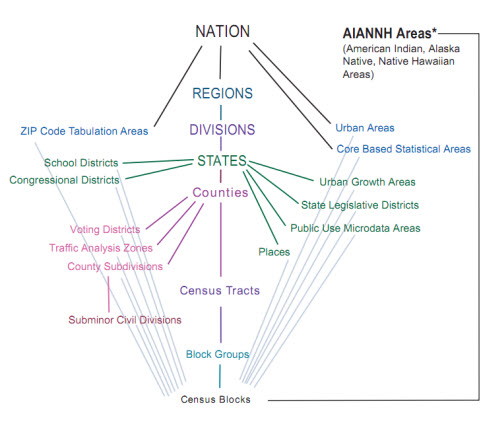
Demographic data as provided in our products CDXZipStream and CDXStreamer is based on various census geographies. But what do we really mean here by "geography"? It's really just the way the U.S. Census defines a geographic area in the United States, and many census geographies, such as states and counties, we're already pretty familiar with. However, have you ever heard of a Census Designated Place, or CDP? How about a Core-Based Statistical Area, or CBSA? If you're interested in using demographic data to find a location for your business, design a marketing program, or even perform academic research, you may find these less well-known geographies useful.
The most basic census geography is the census block, which is well-named since it is the building block for just about all other geographies. For the 2010 census there are over 11 million census blocks covering the U.S., the District of Columbia, and Puerto Rico. Since it is the smallest geography, census blocks can be grouped together to form larger geographies such as counties, states, and regions. Here's a helpful diagram provided by the Census Bureau, with the smallest geographies at the bottom, and the largest geographies at the top:

Census blocks are typically defined by physical features like roads or rivers, and other boundaries such as city limits or property lines. They can correspond to individual city blocks, but in rural areas may cover much larger areas. Population is also a factor; the average size nationally of a census block is about 100 people.
Here are some other census-specific geographies of interest:
Census tracts are geographic units representing urban or rural neighborhood-like communities, and are made up of adjoining census blocks. Census tracts, like blocks, usually coincide with the limits of cities, towns or other administrative areas, and several tracts commonly exist within a county. There are just over 66,000 census tracts covering the U.S., with an average population of about 4,000. Census tracts can be extremely useful for demographic analysis since they are fairly stable, well-defined entities that are large enough to get statistically-significant data, but small enough to see a unique picture of the community.
Places are a catch-all geography that lumps together a wide variety of communities such as cities, towns, boroughs, townships, villages, and municipalities. This category also includes CDP's (Census Designated Places) which are populated communities that do not have a local government and are not incorporated. Examples include small rural areas and unincoporated retirement communities. Using census data for "places" can be particularly useful for smaller communities where the population is fairly homogenous, but for large cities such as New York, demographics by place can provide only a limited picture of a very diverse population.
Core-Based Statistical Areas are urban areas with a population of at least 10,000. CBSA's are defined by the U.S. Office of Management and Budget, and are determined more by social and economic ties within an area, rather than physical or political boundaries. As a result, they can cover multiple counties, cities, and even states. There are currently 955 CBSA's in the U.S., which are grouped according to population. An area with a population between 10,000 and 50,000 is a Micropolitan Statistical Area, and an area with a population greater than 50,000 is a Metropolitan Statistical Area. Since CBSA's are a truly functional geography that reflect where people live and work, they can provide a very unique demographic perspective on the area.
Zip Code Tabulation Areas, or ZCTA's, are the Census Bureau's version of zip codes, and were first developed for tabulating Census 2000 data. ZCTA's approximate zip code areas by aggregating census blocks. But since zip codes as defined by the U.S. Postal Service are ever-changing and do not follow census boundaries, there will always be some discrepencies between the two. ZCTA's of course are extremely useful since they can easily be linked to a mailing address, but it should be recognized that ZCTA's and zip codes are not exactly the same thing. One of our recent blog posts reviews ZCTA's in more detail.
For more information about census geographies, here are some good resources:
Reference Resources for Understanding Census Bureau Geography
Census Bureau Geography
Metropolitan and Micropolitan Statistical Areas
Zip Code Tabulation Areas